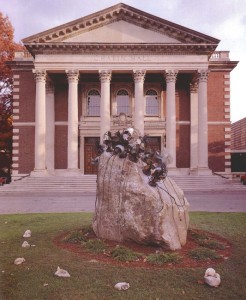The Supreme Judicial Court of Massachusetts (the state’s highest court) recently issued a surprising decision that permits claims against Harvard arising out of a series of daguerreotypes taken of the plaintiff’s ancestors in the 19th century by famed professor Louis Agassiz to proceed. While the SJC affirmed the dismissal of the plaintiff’s property claims that sought outright ownership, the court reinstated claims for emotional distress. The decision held that the manner in which an educational institution responds to a grievance about something in its possession may itself be actionable in the context of the institution’s relationship to the historical facts. In stretching the bounds of the traditional causes of action for negligent or reckless infliction of emotional distress to reach a sympathetic set of facts, however, the SJC has effectively abolished limits on museum liability for collections created under problematic circumstances where the response to such claims is attacked creatively enough. The issue is not whether the result is fair to Harvard, or whether the plaintiff’s family deserves recognition and justice for what was done—they do. The problem with cases that are hard or impossible to limit is that they may lead to socially positive outcomes in one instance, but can be weaponized in the next. In an era when all manner of actors are politicizing what universities should or shouldn’t teach, this opinion creates innumerable opportunities for mischief. As a result, it raises First Amendment and Due Process concerns that Harvard might plausibly petition the Supreme Court to address.
Harvard Can be Sued Over Louis Agassiz Slave Daguerreotypes from 1850
Topics: due process, Supreme Judicial Court, SJC, Harvard, First Amendment, Museum of Fine Arts Boston, NAGPRA, Tamara Lanier, negligent infliction of emotional dismiss, Louis Agassiz, Daguerreotype, Renty Taylor, Delia Taylor, MFA, reckless infliction of emotional distress, Philip Guston, Drew Gilpin Faust
This Painting is My Speech, This Painting is Your Speech—Government Scores a Win in Capitol Painting Controversy
A controversial painting removed from display at the U.S. Capitol will not be returning to display after the U.S. District Court denied a request for an injunction before the exhibition in question came to an end. While the court acknowledged that St. Louis teenager David Pulphus’s Untitled #1 had been removed based on its viewpoint, it ultimately held that Pulphus was not the one “speaking,” the government was. As such, it was free to do as it wished. The court’s opinion carefully considered the factors that determine whether the speaker is the government or a private citizen, but as it acknowledged, the line can be hard to draw. The opinion has implicationsfor other cases where art in public spaces stirs controversy.
Topics: Wm. Lacy Clay (D-MO), First Amendment, Ferguson Missouri, St. Louis, Dave Reichert, Duncan Hunter, David Pulphus, public forum, government speech, Thomas P. (“Tip”) O’Neill, Jr.
Battle Over Controversial Student Art in U.S. Capitol Lands in Court—First Amendment in Focus Again
For several weeks earlier this year, an odd battle was waged in the halls of the U.S. Capitol over a controversial work of art by a high school student placed there after an art competition in St. Louis. At issue is whether the Architect of the Capitol had the right to direct the permanent removal of the painting, or whether doing so violated the student’s (or his Congressman's) First Amendment Rights. That student, and the Congressman, have now gone to U.S. District Court in Washington, DC to get an answer. As in the past, strong feelings on all sides about police officers in particular have sharpened the debate about how, when, and whether the government can be selective in its displays of expressive visual art. With that said, the ostensibly retroactive application of Capitol rules to disqualify a painting that had previously passed those very same guidelines seems unlikely to pass First Amendment muster.
Topics: U.S. House of Representatives, Richard Serra, First Amendment, Tilted Arc, Ferguson Missouri, St. Louis, William Lacy Clay, Eugene Volokh, Dave Reichert, Duncan Hunter, Capitol, Michael Brown, Tip O'Neill
Exhibition Interference Shows That Public Institutions Still Struggle with First Amendment
Use of Confederate Flag in California Painting and Klan Imagery in Massachusetts Leads to Removal of Controversial Works
Two recent interventions by public authorities to remove controversial works of art underscore that, like last year’s Leonard Peltier painting dispute, the proper application of the First Amendment remains more elusive than it should. In California, a state law prohibiting the display of the Confederate flag led to the removal of a specific painting from an exhibition, while north of Boston at Salem State University, a painting depicting figures in Ku Klux Klan robes was shut down entirely. Together, these examples provide a useful of what state authorities can, and cannot do with regards to messages they find offensive. The difference is very important.
Topics: Ku Klux Klan, The Boston Globe, Confederate Flag, First Amendment, Leonard Peltier, Salem State University, Timothy Desmond, Civil War, Garry Harley, Fresno, State of the Union
Don’t Shoot the Messenger—Student Art Removed, First Amendment Notwithstanding
Last fall we had occasion to address the extent to which public displays of art and attempts at controlling the content of them can run afoul of the First Amendment. In that case, public outrage at artwork submitted by controversial Native American activist Leonard Peltier, who was convicted of murdering in 1975 two FBI agents, led to the removal of Peltier’s paintings by the public agency that had organized the exhibition.
A new controversy in Colorado has underscored similar First Amendment concerns. On March 15, an exhibition of high school student art opened at the Wellington Webb Municipal Building in Denver. One tenth grader submitted a painting that has set off a firestorm. The background of the painting shows an American flag, which is peeling away at the center to reveal a Confederate battle flag.
Topics: First Amendment
“Mattress Performance” Title IX Lawsuit Against Columbia Is Dismissed
Last May, a former Columbia University student sued the university over the circumstances around Emma Sulkowicz’s widely publicized “Mattress Project,” in which Sulkowicz vowed to carry a mattress around campus so long as the plaintiff, a man named Paul Nungesser whom Sulkowicz had accused of sexual assault, remained on campus. Nungesser’s lawsuit was dismissed on Friday. In addition to the interesting tactical aspects of the case—most prominently Nungesser’s decision to sue Columbia, but not Sulkowicz, who if Nungesser is to be believed has been defaming him—the dismissal is an important result in the growing campus battles over efforts to try to enforce prohibitions against expression or restrict the ability to give offense. In that sense the dismissal is a welcome result.
Topics: Columbia University, Title IX, Paul Nungesser, First Amendment, The Mattress Performance, Emma Sulkowicz, Establishment Clause
Leonard Peltier and Public Displays of Art—The Government Taking Sides on Whose Paintings are Shown Stirs Up First Amendment Problems
An exhibition in Washington (state) that included art by a number of Native Americans, including Leonard Peltier, has provoked an outcry that may have Constitutional dimensions that went unconsidered. Peltier is a controversial Native American activist who was convicted of murdering in 1975 two FBI agents, Jack R. Coler and Ronald A. Williams. His conviction has long been a Rorschach Test for responses to Native American activism and the federal government’s response—Peltier has strenuously insisted he is innocent, and the FBI has adamantly maintained he was properly convicted. This has now raised its head in the realm of the public display of art, and whether the government may, or should discriminate among artists. After an outcry about the inclusion of Peltier’s art by a number of current and retired law enforcement officials, the Washington Department of Labor and Industries has announced that it will remove Peltier’s paintings from the display that marked Native American Indian Heritage Month there, and has apologized. Yet regardless of one’s opinion if Peltier’s guilt or innocence, the government has stepped in a First Amendment quagmire when it made a public forum available for expression and then removed the expressive work of only one person because of who he is. The First Amendment, after all, acts to protect expression regardless of popularity, indeed, particularly so. It is hard to argue that his work was removed for any of the reasons that courts generally permit restrictions on speech in the various kinds of public forums. It remains to be seen whether Peltier will object on those grounds.
Topics: Ray Lauer, Wounded Knee, Ronald A. Williams, North Dakota, Florida, South Dakota, American Indian Movement, Native American Indian Heritage Month, Pine Ridge Reservation, Native American, Coleman Federal Correctional Facility Coleman, National Retired Agents Association, Washington Department of Labor and Industries, First Amendment, Guardians of the Oglala Nation. GOON, Jack R. Coler, AIM, Leonard Peltier, Lakota Sioux Chippewa
Anish Kapoor in Versailles: Requiring Removal of Graffiti Turns Into Compelled Speech
Back in June, sculptor Anish Kapoor installed the sculpture Dirty Corner on the grounds of the famous palace there. Kapoor, who can’t seem to avoid public controversy over his work, saw the sculpture first become the object of debate with regard to its form itself, specifically, the suggestion that the shape of the large work was anatomical. Kapoor coyly fostered speculations about what it was meant to represent, but ultimately demurred that his “work has multiple interpretive possibilities." With recent vandalism and a court order that he remove the graffiti, however, the story has turned into one more about free expression and compelled speech. So far, it does not have a happy ending.
Topics: Rock Fan, Versailles, The Art Newspaper, Fabien Bouglé, Ku Klux Klan, Dirty Corner, Graffiti Art, France, Williams College, Fleur Pellerin, Nazis, Palace of Versailles, Confederate Flag, Richard Serra, Catherine Pégard, refugee crisis, Williams College Museum of Art, First Amendment, Yardbird Suite, Anish Kapoor, François Hollande, vandalism, anti-Semitic, Graffiti, Amherst College, Tilted Arc
Did Philadelphia Inadvertently Step on First Amendment and VARA in Painting Over Cosby Mural?
Few things have brought consensus recently more than the revulsion over the allegations against comedian Bill Cosby, a Philadelphia native. Yet in a desire to distance itself from Cosby, the city may have crossed a First Amendment line when a well-known mural entitled “Father’s Day” that depicts Cosby was painted over. And even if the city did not run afoul of that constitutional protection, the artist of the mural may have had under the Visual Artists Rights Act of 1990, 17 U.S.C. § 106A (VARA) rights too. Ultimately it will come down to whether the artist or artists object to the fact or the timing of the removal—an objection that would not necessarily be any endorsement or support of Cosby (or have anything at all to do with Cosby), but which might relate more to the right of expression.
Topics: Philadelphia Inquirer, King Jr., Philadelphia, Visual Artists Rights Act of 1990, Martin Luther, VARA, Philadelphia City Mural Arts Program, Temple University, University of Massachusetts, 17 U.S.C. § 106A, Nelson Mandela, Bill Cosby, The Washington Post, First Amendment
Order Restored—Copyright Claim to Individual Performance in “Innocence of Muslims” Fails
The full en banc panel of the Ninth Circuit Court of Appeals has reversed the earlier three-judge panel decision concerning a claimed copyright in the notorious Innocence of Muslims film. The full panel rebuked—wisely—the earlier panel’s holding that Cindy Lee Garcia had an independent and enforceable copyright in her acting performance that would allow her to enjoin reproduction of the video (on YouTube, in particular). Garcia’s case failed both for threshold reasons of fixation, and larger issues of copyright and the First Amendment. The case is a sympathetic one, but the ruling that has now been overruled was an unworkable one that needed to be corrected. Many of the problems and ramifications of the earlier opinion that we have noted were echoed in the decision.
Topics: Copyright Act, Libya, Digital Millennium Copyright Act, DMCA, Youssef, YouTube, Innocence of Muslims, prior restraint, 17 U.S.C. § 106, Cindy Garcia, Copyright, First Amendment, Google, Benghazi, work for hire



.jpg)



